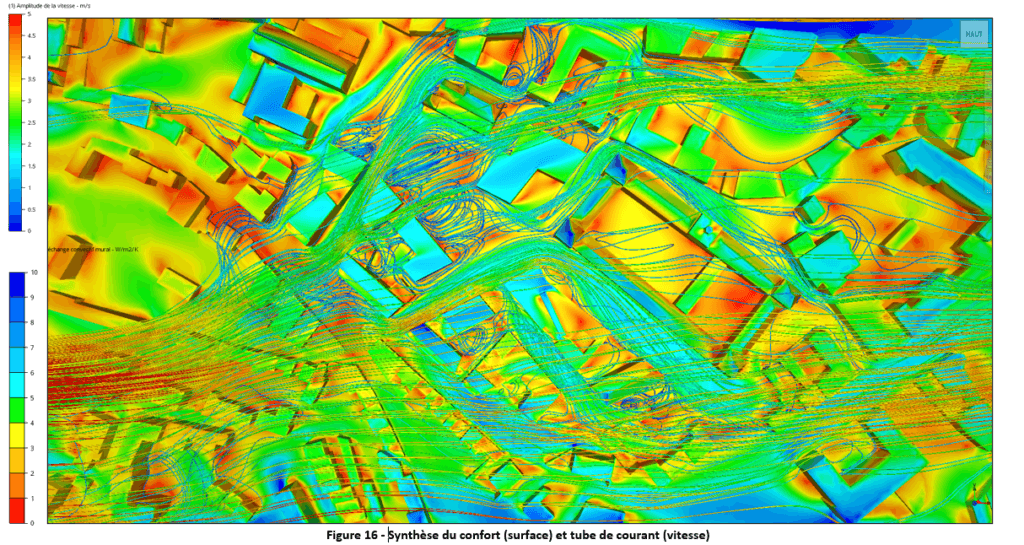Study of exterior thermo-ventilation comfort
Accueil » Expertise » Air & Wind » Study of exterior thermo-ventilation comfort
EOLIOS assists designers in the implementation of technical and natural solutions to optimize urban comfort:
- Verification of pedestrian comfort
- Study of urban heat island effects
- Calculation of pressure coefficients
- Study of wind comfort in outdoor spaces
- Sizing of wind protection solutions
- Proposal for an urban development master plan
- Urban project impact study
- Vegetation optimization
- Study of the propagation of pollutants
Continue browsing :
Our latest news:
Our projects :
Our fields of intervention :
The effects of the wind in the city
As the wind blows around buildings and spaces, its speed and direction change. Each wind direction creates its own areas where the wind slows down or, on the contrary, speeds up. However, the wind is unstable and is characterized by an uneven repeatability of its directions and speeds along the cardinal points, which can be known for each locality from the results of meteorological observations over several decades.
The combination of wind CFD results for all possible wind directions (taking into account the frequency of these directions) clearly demonstrates the differences in wind regime between different parts of the territory, which determines the different comfort levels of the urban space.
Timely comfort assessment during the design phase allows for optimization of the master plan and consideration of several comfort measures necessary to ensure efficient use of open space.
Comfort and safety in the wind
Comfort and wind safety for pedestrians are essential requirements in urban areas. Many municipalities are requesting studies on the comfort and wind safety of pedestrians when designing new buildings and new urban areas. These studies consist of combine statistical meteorological data, aerodynamic information and performance criteria comfort and safety in the wind.
CFD simulation allows modern aerodynamic calculations to be used in a wide range of architectural and construction projects.
What is a pedestrian wind comfort study?
Pedestrian wind comfort studies take into consideration weather data, aerodynamics and comfort criteria. Simulation can numerically model the airflow over and around a building or urban area and is a faster and less expensive approach than physical wind tunnel experiments.
By evaluating pedestrian wind comfort with CFD, EOLIOS engineers can understand the behavior of the wind around the buildings at an early stage and participate in iterative design processes. Wind speeds and other parameters can be calculated at the pedestrian level, and comfort can be assessed based on given criteria. The study of several wind directions allows to foresee the worst case and to anticipate any problems from the beginning of the design process.
Without wind studies, many negative consequences can occur on the streets, ranging from discouraging shoppers from visiting stores, parking on patios to real safety risks for pedestrians and cyclists, and even threatening lives in extreme cases.
Why conduct wind flow studies at the neighborhood level?
Airflow comfort can have a significant impact in public spaces. Indeed, if the wind blows too hard, the attractiveness of a square, a café, a terrace… will be less important. However, it is impossible to completely counter the effects of wind by buildings or protections, because the aeraulic flows circumvent the obstacles and are amplified thereafter. This is why there are different methods , more or less important and effective to protect ourselves from the wind that we are led to propose to urban planners.
It is possible to work at different scales:
- The scale of the neighborhood by playing on the layout and size of the buildings, the arrangement of the streets, the uses of the squares, the creation of meshes and islands of comfort.
- The scale of the building by installing urban equipment such as awnings, screens, windbreaks, nets...
- On the species and the vegetation of the spaces
We are specialized in the modeling and the understanding of the aeraulic phenomena, within this framework, we accompany the designers by carrying out studies of the external microclimate within the framework ofstudy of impact or for the realization of mission ofstudy of comfort to the wind.
Easy-to-access collaboration tools
Example of dynamic content for the study of urban comfort in La Défense.



